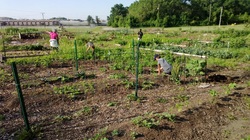 By Laureen Fagen So your garden was going great – lots of beneficial rain and warm spring days that turned to summer heat. The Fourth of July weekend was fun and the break was well-deserved, since most of your planting is done and the weeds are under control. It was even time to enjoy the cucumbers and a few tomatoes. And that’s when it happened, right? The zucchini plants suddenly looked as if they’d been dusted in baby powder. There are some scary-looking spots all over the black-eyed Susans, and mysterious holes in the raspberry leaves. There are filmy webs on the cabbage, and little horned fiends looking well-fed. I hate this, and the reason is because I feel helpless and inadequate and I don’t know what to do. Maybe not about every insect pest or fungal disease in the garden – but enough for me to see a lengthy battle. It makes me wonder sometimes how humans ever grew enough food to thrive, and avoid our extinction. It’s true that you can avoid a lot of problems by catching them early, so it makes sense to walk the garden every day. But then what? Here are a few ideas for diagnosing/treating some plant problems: · Gather all the information you can. What was the weather like? In a spring this cool and wet, there will be a lot more fungal problems. What is the plant doing based on what you’ve seen before? The powdery mildew is pretty common in the cucurbit family – your squash, your zucchini – and the humidity makes it likely, but there’s more than one kind to deal with, too. Ask yourself all the questions first, and then start fitting the plant-science puzzle pieces together. · Don’t be afraid to ask, whether that means asking a friend or double-checking the symptoms with photos on the Internet. Just be sure that you trust the information comes from a reputable source. This is a good way to see what a problem can’t be, too, before you decide on what it is. · Act early. Start removing the tomato hornworms or squash bugs from the plant as soon as you see them. Prune away obviously infected parts of the plant, and keep them out of the compost. Decide how you want to manage the problem and by what method, and then remember what worked (or write it down) because you’re likely to see the problem again in other seasons. Try to remember, too, what you think may have caused the pest or the pathogens in the first place. · Freak out! No, not always. Many plants experience common pest or disease problems without destroying the plant, or even needing much treatment. On the other hand … Freak out! I think that’s a downy mildew on the black-eyed Susans, and it’s a completely different problem than other mildews I’ve had before. The Plasmopara halstedii does infect the rudbeckia, along with other daisy-family flowers, and all of this water isn’t helping. It’s a little late for prevention and I have it in three different beds on two different sites, so feel free to send me your best ideas! I love Laureen's thought on Gardening we all feel overwhelmed at sometime in our garden. I combat garden fatigue in August by refreshing my garden. I start tearing out stuff that has died or is going to seed and replant . Here are a few links to guides for fall planting Planting Chart From Natures Crossroads Purdue Fall Planting Guide Happy Gardening Mitch
2 Comments
 So the last week has had its up and downs. As a precaution Unity Gardens test all of its sites for lead, and if it in a area of concern we have a full panel done. In the past 5 years we have only had one garden not pass. This week we had a 2nd garden. While the levels were below what the EPA would consider unsafe to grow in we did not want to take any chances. But it got a little news coverage and got me to thinking about spending some more time teaching people about safe garden practices. We do teach some classes in the winter and touch on soil safety, but this just presents another chance. So should you be concerned ? First know a little history of the lot you are growing on. Is it an old dump site, or a site where a house burned down.? Old cars leak toxic chemcials into the soil, and fire ruble can contain all sorts of things. If your house is pre 1978 and has been painted with lead paint the soil could have lead in it. This is not meant to scare people off from gardening most areas are safe, but if you have concerns it does not hurt to check. The best place to start is the health dept. here is a link to the St Joe Co Website . There are some ways you can make your garden safer. Raised beds, and mulch in between the beds goes a long way. Most of the exposure to lead is from dust that gets on the food. Washing your food in the garden and then again in the home can also help. Check out this Soil Safety PDF Happy Gardening |
ContributorsWe love to feature blogs from all of the members of our team, including core staff, interns, volunteers, and others. We hope you enjoy the stories and find the information useful! Archives
January 2023
Categories |
AddressLaSalle Square
3701 Prast Blvd. South Bend, IN. 46628 |
Hours
Garden: always Welcome Center Mon-Sun: 9am-7:30pm |
Telephone574-222-2266
After Hours: 574-315-4361 |
Unity Gardens
PO Box 10022 South Bend, IN. 46680 |

 RSS Feed
RSS Feed